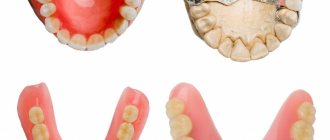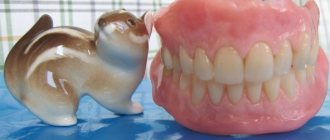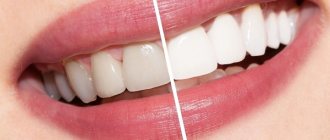What are the features of prosthetics for anterior teeth?
Any specialist understands perfectly well how important his smile is for a person, because it is a kind of business card, which means it is the first thing we pay attention to when meeting or getting to know each other. A lot depends on its beauty: the success of the transaction, personal relationships and - most importantly - the psychological state of its owner. Therefore, every time doctors are faced with the need to restore a front tooth, they are faced with an important and difficult task: to quickly and efficiently carry out the procedure. Prosthetics of the front tooth requires not only the correct recreation of the function, shape and color of the tooth, but also requires paying special attention to the “pink aesthetics”, that is, the gum.
Types of dental prosthetics
Today in orthopedic dentistry there are two main directions: restoration of damaged teeth and prosthetics of missing ones. They also distinguish between removable and non-removable dental prosthetics, and separate dental prosthetics on implants.
When a tooth is destroyed, function and shape can be restored with the help of crowns and veneers. Dental prosthetics requires a thorough analysis of each case and precision execution. To the patient, the prosthetic process seems complicated, and many of the dentist’s actions are incomprehensible and a little strange. But the orthopedic dentist knows what he is doing, his every movement has its own meaning. The process is really complicated, but experience and knowledge help the specialist, everything turns out well.
If one or more teeth are completely missing and it is impossible to make a bridge, the most optimal method is implantation. It is popular not because of fashion, it simply gives the highest quality of the final result.
Features of pricing for dental prosthetics on implants
Of course, dental implants are more expensive than traditional dental bridges. But we must take into account that in the case of dental implantation, another group of specialists is included in the process of restoring the dentition - an implantologist, an assistant doctor and an operating nurse. This highly professional team of doctors works as a well-coordinated team, and it is thanks to the fact that they work well together that the operation proceeds not only quickly, but also successfully.
In addition to the remuneration of these specialists, the cost of the implants themselves, instruments and related consumables should also be taken into account. These are high-tech, high-quality medical products, they are not cheap. An attempt to replace them with inexpensive analogues worsens the final quality and success of the implantation operation.
At the same time, it should be taken into account that most cases of adentia in the oral cavity can be solved using traditional methods of dental prosthetics. Of course, for a high degree of reliability and beauty, you should not use methods that have long proven ineffective - all kinds of stamped steel crowns or dentures made of samovar gold.
To achieve a smile that is inseparable from a person’s image, orthopedists successfully use effective modern methods of dental restoration. Thanks to these technologies, restored teeth are practically no different from living ones, and the time required for prosthetics has been significantly reduced. At the same time, the service life of modern high-tech dentures has become comparable to the lifespan of a person.
Which dental prosthetics is better in terms of quality and price?
The types of prostheses and methods of dental prosthetics in modern orthopedics are very diverse, which makes it possible to select dental restoration options individually for each patient. Methods and types of dental prosthetics depend on the condition of the patient’s teeth and gums, as well as on his aesthetic preferences and financial capabilities. The cost of dentures for teeth can vary tenfold. At the same time, patients should be advised to adhere to the golden mean and healthy conservatism in their approach. New treatments are always significantly more expensive. Outdated types of prostheses are cheap, but unreliable.
But proven types of prostheses are quite affordable and at the same time provide a service life for decades. In terms of dental prosthetics, metal ceramics can be noted. It is reliable and quite beautiful, although it is somewhat inferior in beauty to zirconium structures and pure ceramics, however, not so much as to call this indicator critical. Read more detailed reviews on the features of prosthetics with metal-ceramic structures on the following pages of the site.
In what cases are veneers used to restore front teeth?
If the problem is minor damage in the area of the front teeth, such as cracks or minor chips, as well as in cases where a person is not satisfied with the shape and color of the front teeth, it is advisable to correct the defect by installing ceramic veneers. A veneer is a thin porcelain plate no more than 0.3 mm wide, which is fixed to a ground tooth using composite cement. Modern materials from which veneers are made are very durable, hypoallergenic and can imitate almost all shades of natural enamel, as well as its transparency. Many modern dental clinics in Moscow, which provide prosthetics for front teeth using this orthopedic design, can offer the installation of veneers during one visit to the doctor. With careful care, such ceramic restorations will serve their owner for at least ten years.
What are Lumineers and when are they used?
Lumineers are another type of orthopedic plates designed primarily to correct the color and shape of the tooth surface. The installation of lumineers, unlike veneers, is carried out in one visit and does not involve grinding of the dentition. That is why there is no need to wear temporary structures before installing them. Lumineers also have an undeniable advantage over composite restorations: thin ceramic plates do not darken over time.
However, there are also disadvantages. Since lumineers are installed on an unground surface, it is sometimes very difficult to achieve a tight fit to the teeth. In addition, the tooth on which the lumineer is attached differs from the natural dentition in size and shape, so it is not recommended to correct local defects with its help.
How is prosthetics performed for severely damaged front teeth?
Modern prosthetics of anterior teeth in many cases involves the use of an old proven method - installing a crown. This prosthesis is a protective frame that is put on the ground remaining part of the tooth and completely repeats the shape and color of the lost crown part. The need to use this orthopedic design arises in cases where the tooth is destroyed by more than 50%. Before installing it, the doctor grinds down the tooth (what’s left of it), and only then puts on the “cap,” that is, the crown itself. Modern specialists prefer to prosthetize the front teeth using the most aesthetic type of crowns on a frame made of lithium disilicate, feldspathic ceramics and zirconium dioxide.
What removable dentures look like in the photo
Of course, from an aesthetic point of view, fixed structures will compare favorably with removable dentures. Despite the constant improvement of removable products, they will always cause discomfort to patients when speaking and cause irritation of the mucous membrane. Also, when using them, especially in the first time after installation, diction may suffer. In addition, their service life is quite short; even the best devices will last about 5-7 years.
However, there are times when it is not possible to resort to permanent prosthetics. This may be due to significant loss of most teeth, complete edentia, or due to financial capabilities. Not all patients have the opportunity to undergo expensive implantation; for them, removable devices will be a good way out of this situation.
Removable dentures are affordable, performed quickly, and allow you to restore the aesthetics of your smile and restore functionality to your teeth. Dentures cope quite well with chewing food and help avoid problems associated with disruption of the digestive system and changes in the shape of the face.
Acrylic dentures made of hard plastics
Acrylic structures are especially popular among patients who are faced with partial or complete absence of teeth. Dentures are held in the mouth due to the suction effect or fixed with hooks if supporting teeth remain. The designs look quite natural, allowing the patient not to worry about appearance, but they can cause significant discomfort during use and reduce the sensitivity of taste buds.
Acrylic dentures: before and after photos
Soft and elastic removable dentures
Soft dentures (nylon, Acree Free, polyurethane or Quadrotti) are leaders in the field of fixed prosthetics when it comes to aesthetics. The base of the product, that is, the gum bed, is made of soft and elastic plastic. Pinkish-transparent, it perfectly imitates gums, and plastic artificial teeth look very natural. The dentures do not cause any discomfort to the patient, are very flexible and hypoallergenic, and are suitable for use in the presence of weakened and sensitive mucous membranes. They are fixed in the mouth on gums or hooks that have a pinkish tint - they are also made of plastic.
Nylon dentures
Clasp structures with a metal base
Dentures on a metal arch are used in cases of partial absence of teeth. They can be attached to adjacent teeth using hooks (but then it is better not to use them to eliminate defects in the frontal smile area, since the hooks can be noticeable when talking or eating). The best aesthetics on the front teeth can be achieved with fixation with locks or using telescopic crowns.
Clasp prosthesis: before and after photos
How are missing or severely damaged teeth restored?
Dental implantation is considered the most reliable and optimal option for restoring missing or unrecoverable incisors. Implants do not require grinding of adjacent teeth, and their installation has virtually no contraindications. Implantation is considered the best option for prosthetic treatment of anterior teeth for periodontitis. When reconstructing teeth in the anterior region, specialists prefer to work using an accelerated method, that is, to carry out one-stage implantation. It makes it possible to completely restore a tooth in one visit to the doctor and maintain the correct contour and volume of the gums. The patient is given an implant, and immediately after that a temporary crown is installed, which completely restores the aesthetics of the smile. However, it must be remembered that one-stage implantation is possible only under certain conditions. Otherwise, if for some reason it is impossible to immediately install a temporary crown, the doctor still does not let the patient go “with a hole instead of a tooth,” but temporarily covers it with a removable denture.
Why implantation?
All methods of dental prosthetics prior to implantation negatively affect the condition of the oral cavity in the future, often causing premature wear and loss of teeth. In particular, the manufacture of bridge-like prostheses - bridges, as they are also called - requires the depulpation and preparation of two, and sometimes three, teeth to replace just one lost tooth.
Such radical treatment, to put it mildly, is not beneficial for the jaw system and leads to overload of the supporting units with further root inflammation and tooth loss. At the same time, the average service life of “bridges” is 6-7 years.
The situation with removable dentures is even more complicated: for any removable device, the support is the gums and bone tissue of the jaw, which, in principle, is not adapted to a full chewing load. As a result, a chronic inflammatory process develops, and the bone atrophies and dissolves.











